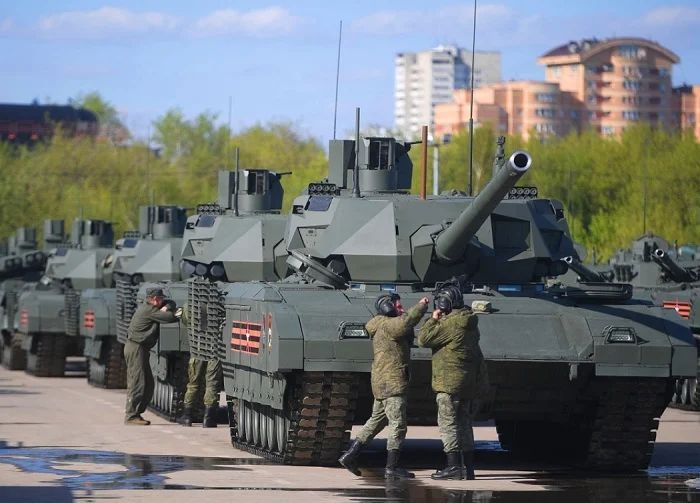Taking the Military-Technical Cooperation (MTC) between the two countries to a new high, Russia has offered India "new areas of work", including developing together new armoured vehicles based on the T-14 Armata tank platform.
The negotiations to create exclusive equipment based on the Indian military's specifications took place during the meeting of the Inter-Governmental Commission on Military and Military-Technical Cooperation held in New Delhi on December 6.
Defence Minister Rajnath Singh and his Russian counterpart Sergey Shoygu had co-chaired the discussions which were held just a few hours before the 21st India–Russia Annual Summit between Prime Minister Narendra Modi and Russian President Vladimir Putin.
"The Indian partners were offered new areas of work, including the creation of armoured vehicles based on the customer's specifications on the Armata platform, especially given that the Indian military is planning to expand work on the creation of a new main battle tank," Valeria Reshetnikova, the Press Secretary of Russia's Military-Technical Cooperation (FSMTC), told Russian state-owned domestic news agency RIA Novosti in an interview on Tuesday.
Reshetnikova said that the Russian weapons, including new models, are of great interest among buyers of military products which is confirmed by the volume of contracts being concluded with several partner countries, amounting to billions of US dollars.
Russia's newest and state-of-the-art T-14 Armata battle tank has been showcased at various international military and technical forums since its first public viewing at the Victory Day parade in Moscow on May 9, 2015.
The Armata uses unprecedented design solutions, in particular, the T-14 tower is uninhabited. The crew is placed in an armoured capsule, separated from the ammunition. The original silhouette, combined with the use of a special coating, significantly reduces the visibility of the vehicle in the thermal and radar spectra of observation.
It is capable of withstanding any existing anti-tank weapon hit. The tank is equipped with active and dynamic protection, equipped with a remotely controlled combat module with a powerful cannon and an automatic reloading system. Optical-electronic devices for observation, aiming and threat detection are installed along the perimeter of the tower and the hull.
The Russian Defence Ministry says that the main combat characteristics of the Armata T-14 tank are a high degree of passive and active armour protection, which is superior to any other types of armoured vehicles; as well as high cross-country mobility and great firepower.
Also Read: Ahead of his visit, Putin praises India as one of the hubs of a multipolar world
It is armed with a 125-mm new generation tank gun with a prospective ammunition load and a digital fire control system.
Also, the T-14 is equipped with the most modern on-board complexes. The crew members' workplaces are equipped with video devices with touch-sensitive controls.
As the full cycle of tests of the T-14 Armata tank neared completion, Russia had planned to supply about 20 of them to its troops by the end of this month.
Russian Defence Minister Sergei Shoigu holding the final conference call of the year on Tuesday with the leadership of the country's armed forces
In a briefing for the military attaches of foreign states earlier this month, Russian military chief General Valery Gerasimov said that new samples of armoured vehicles on the Armata, Kurganets and Boomerang platforms would increase the strike capabilities of the Russian ground forces, especially taking into account the new areas of instability around the country's borders.
As reported by IndiaNarrative.com, India, along with China, Algeria, Egypt, Vietnam and Myanmar, remained amongst Russia's main partners in the field of military-technical cooperation during 2021 – a year which has been labeled as "extraordinary" for the country's defence capability by Putin.
As both countries signed an agreement on a programme of military-technical cooperation until 2030 on December 6, both PM Modi and Putin had expressed satisfaction at the "sustained progress" in the Special and Privileged Strategic Partnership despite the challenges posed by the Covid pandemic.
Just before the Summit, the government had informed Parliament that delivery of the S-400 missile system from Russia, which will significantly enhance the air defence capability of the nation, remains as per the contractual timelines.

"Government is aware of all developments that may impact procurement of defence equipment. Government takes sovereign decisions based on threat perception, operational and technological aspects to keep the Armed Forces in a state of readiness to meet the entire spectrum of security challenges," Minister of State for Defence Ajay Bhatt had said in a written reply in Lok Sabha on December 3.
A contract for procurement of 6,01,427 AK-203 assault rifles was also signed on December 6 between both the countries, the production for which will be done in Uttar Pradesh's Korwa.
New Delhi and Moscow are also working on having joint manufacturing of military equipment in Central Asia.
"The unprecedented level of trust between our countries is evidenced by the intensity and depth of military-technical cooperation, which is reaching a new qualitative level every year," Russian Defence Minister Sergei Shoigu had said in Delhi, a few weeks ago.
Also Read: Stronger Russia promises to step up military partnership with India




















